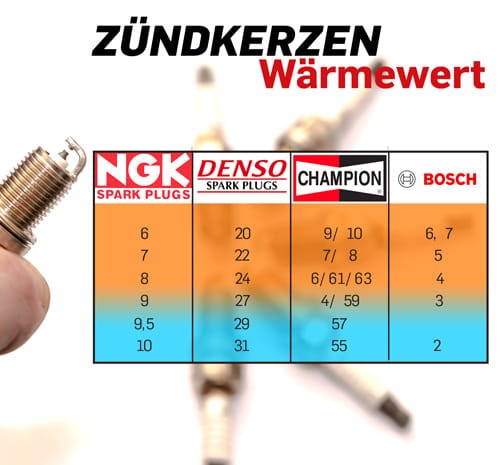Postage free from 99€ (DE)
High customer satisfaction
- Blog
- Spark plugs for Vespa and Lambretta: heat value and conversion

My personal spark plug universe is quite small and simple:
It's always been like this for me and unfortunately it can't stay like this, because my universe has been crumbling for some time now! BOSCH spark plugs have not been around for a long time. Exception: We were able to secure a large stock of BOSCH W3CC.
But that's no reason for my world to collapse, because of course we have great alternatives. The only difference is that they are called something else and the lower value is warm instead of cold ... reason enough to take a closer look at the subject of spark plugs. In our Scooter Center store you can get spark plugs from the leading manufacturers.

Spark plugs are screwed into the spark plug thread of the cylinder head. They are available in various diameters and lengths. The usual threads are M10, M12 and M14.
The common thread lengths are 19 mm (long thread) and 12.7 mm (short thread). You should pay attention to the correct length of the spark plug and follow the manufacturer's instructions.
A spark plug that is too long can damage the piston as it protrudes too far into the combustion chamber. A spark plug that is too short will certainly result in a loss of power, if the engine starts at all. However, unclean combustion would certainly cause residues to form quickly in the combustion chamber, which could cause engine damage.

The heat value is decisive for the thermal fatigue strength of the spark plug and its self-cleaning effect. A distinction is therefore made between so-called cold and hot spark plugs.
The heat value has nothing to do with the strength or performance of a spark plug. A cold spark plug in a cold (weak) engine will become oily or sooty and can break down without damaging the engine itself. A hot spark plug in a racing engine burns up and usually damages it severely.
The heat value of a spark plug is not standardized. Each manufacturer has its own code:
| Manufacturer | Progression (cold → hot) | Values |
|---|---|---|
| NGK | high number = cold | 10 - 9 - 8 - 7 - 6 |
| Bosch | low number = cold | 2 - 3 - 4 - 5 - 6 |
| DENSO | high number = cold | 37 - 34 - 31 ... 20 - 16 - 14 |

Copper, platinum, silver or iridium are used here. Copper is the most common, followed by silver and platinum. Due to the high prices for precious metals, spark plugs are correspondingly more expensive than their copper counterparts.
Ultimately, the material is almost only of interest for wear, only the extremely thin iridium electrodes (Ø=0.6mm) have a higher ignition voltage and the spread of the flame front in the combustion chamber is improved.
The insulator head of the spark plug is made of ceramic. It goes without saying that you should not use brute force here. Spark plugs should be handled with care and it is better not to drop them; they should also be protected from moisture. Use a spark plug wrench with a rubber insert.

Too low: There is a risk of compression loss and overheating. It is also possible that the insulator or center electrode may break due to vibrations.
Too high: This can cause the spark plug to break off. The housing can also stretch or twist. The heat dissipation zones are disturbed and there is a risk of overheating and fusion of the electrodes, which could even lead to engine damage.
The manufacturers recommend a torque wrench for the correct installation of a spark plug. As we know that hardly anyone does this and it doesn't even fit the Lambretta, for example, you could follow the following rule of thumb:
Hand-tight = screw in by hand and then tighten by a quarter to half a turn with the spark plug wrench.
Our new bgm spark plug wrench: protects the spark plug and has a magnet so that you don't burn your fingers when removing the plug.
You can also draw conclusions about the correct combustion of your engine on the basis of a spark plug image.

With a spark plug cap, you should pay attention to whether it is used with or without a spark plug nipple / SAE nut. A spark plug cap is also a part that is exposed to heat and vibrations and should be checked regularly and replaced if necessary. A good spark plug cap only costs a few euros, which you are happy to invest.
